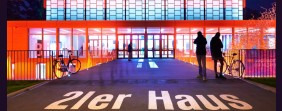Kategorien
- Ausstellungsdoku
- Dokumentation Performance
- Film und Video
- Künstler*innengespräch
- Neues
- Programm
- Veranstaltungen
Blick-Wechsel
185 views
0 favorites
 Anderwald + Grond
Anderwald + Grond
Aristotle is said to have first discovered the camera obscura. Sitting one summer day under a tree, so the legend goes, he noticed crescent shaped light spots around him. What he saw was the beginning of an eclipse, projected on the floor through the effect of the camera obscura. Inside a camera obscura the luminiferous object is projected upside down on the wall in opposite of the diaphragm. For centuries camera obscuras were used to observe eclipses of the sun or moon. Later, the were also in use for military monitoring, as in the year 1552 in Eger where Hungarian soldiers watched the onrushing Turkish troops. It was the time of the Turks first defeat. But the camera obscura was also used in artistic practice, e.g. by Michelangelo for his sketches for the Sistine chapel or by Canaletto for his city panoramas. The interconnection of the invention of photography and the phenomenon of the eclipse lead us to our installation work CAMERA SOLARIS. Spring 2006 we filmed a total eclipse of the sun in Antalya, Turkey on 16mm b&w film. From this material we cut a rhythmic loop.
(Anderwald + Grond)
